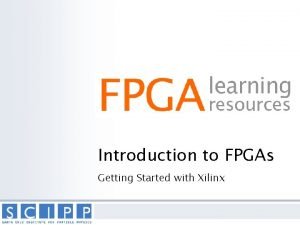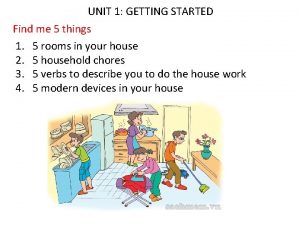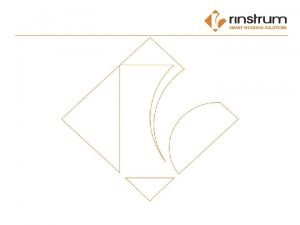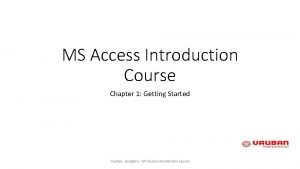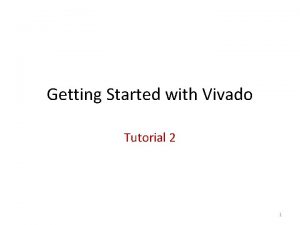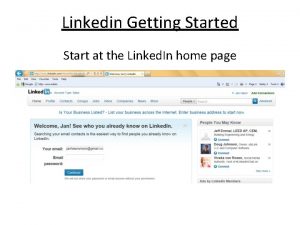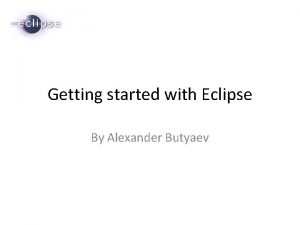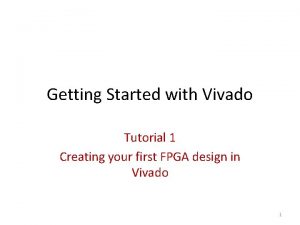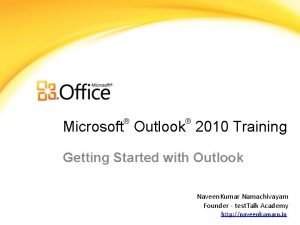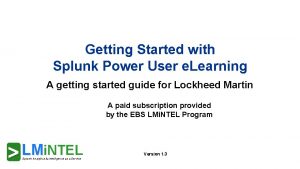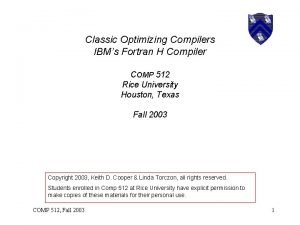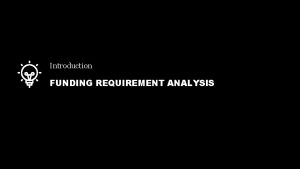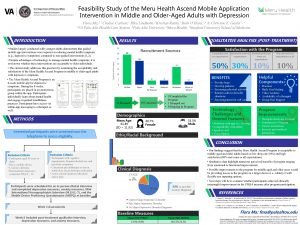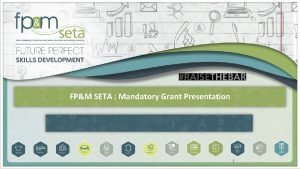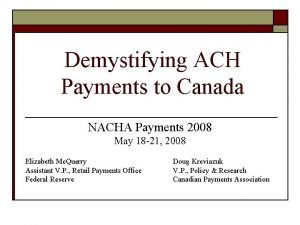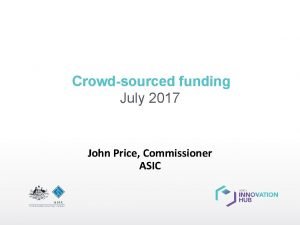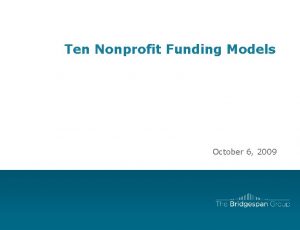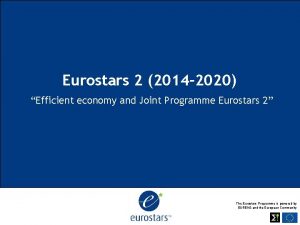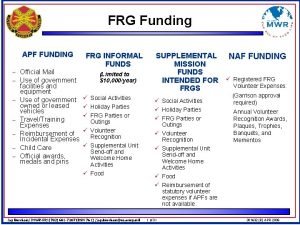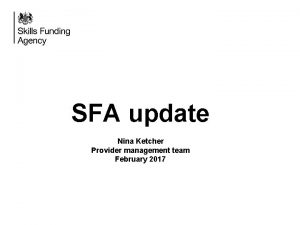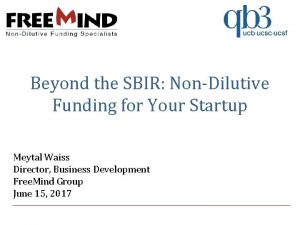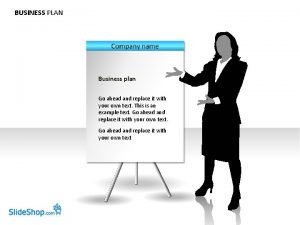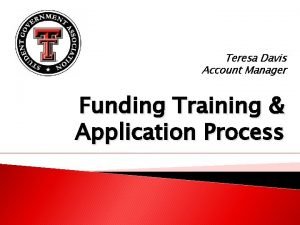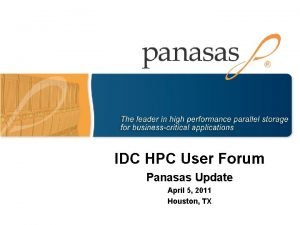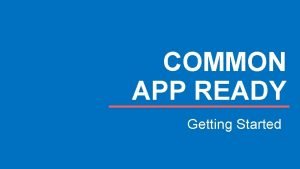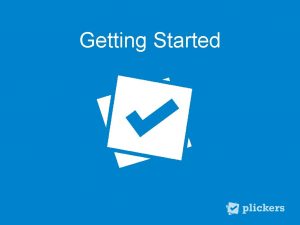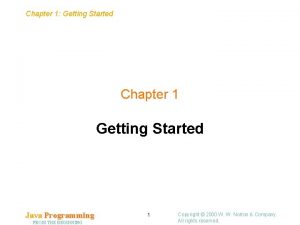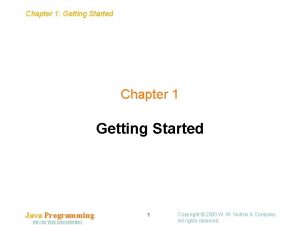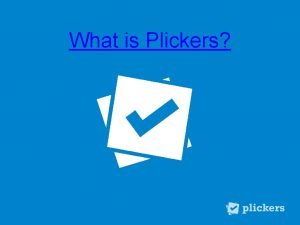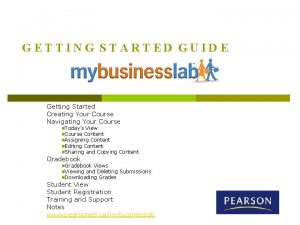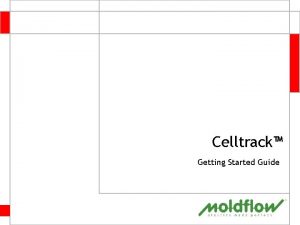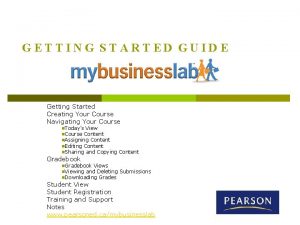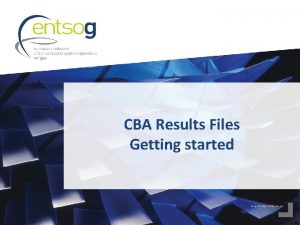Med ecare Optimizing Efficiency Funding Getting Started As































































































- Slides: 95

Med e-care Optimizing Efficiency + Funding

Getting Started As the application is a web based application a unique URL is provided for the user. Access the application with the URL. User needs to enter a valid username, e-mail ID and password in the text fields provided. Click Sign-in button to login to the application Steps to login to the application: • Registered users will get a unique user id and password from Med e-care application • Users should connect to https: //train. mede-care. ca/ecareiv URL through the Internet Explorer • To log into the Med e-care application enter username and password in the login page Note: If the Username and Password did not match then user cannot proceed for further operations

Home Page Once the login process is successful, home page screen appears. Home page screen has the following modules: • e-ADT • e-Assessments • e-Plan • e-Incident • e-Financials • e-Reports

Screen Terminology… Home page has the following fields: • Modules • Calendar • News and Announcements Calendar: Displays the date and month News and Announcements: Displays the details about news events and announcements occurred in the hospital

…Screen Terminology Operational Statistics screen allows executives to keep key information at their fingertips. This feature displays a financial information box which allows user to upon login. It is customizable to the role of each user in the Security Settings. The software also offers summary, real-time information on each client in one convenient location. Note: This feature is displayed in every module of the application. It displays the details corresponding to that particular module. For example: In the above figure it displays the details of e-ADT module i. e Number of admissions, Transfers, Occupied beds etc.

…Screen Terminology Hide Sidebar allows the users to hide the modules and sub modules in the left pane as shown. Note: This feature is displayed in every module of the application. When user clicks on Show Sidebar in the above figure it displays all the modules and sub modules as shown.

Screen Terminology - e-ADT module… The following are the list of fields included in the figure: • Left pane • Selection and Search • Working area • Sorting List Left pane displays the details about modules and sub-modules. Selection and Search Displays the details of Selection filter and Search boxes. It allows the users to admit, search and discharge the clients depending on the categories. Selection filter Includes a drop down menu i. e Complex Continuing Care, General Rehab, Mental Health and All, depending on the category user can admit/discharge a client.

…Screen Terminology - e-ADT module Search: Includes a drop down menu i. e Chart number, Last name, Admitted within past # of days, Health card number, S. I. N. and MAR number, depending on the category user can easily search the clients. Working area displays all the clients details. This information includes Clients name, Chart number, Health sector, Admission date and type etc. . . Sorting List Sorting list includes all the clients’ names in the form of alphabetical order. When user clicks on alphabet ‘B’ it displays the names of the client starting with that particular letter. Note: * Indicates that it displays all the clients’ names in the working area.

…Screen Terminology - e-Financial module The following are the list of fields included in the figure: • Left pane • Working area • Right pane Left pane displays the details about modules and submodules. Working area displays all the clients’ financial details. This information includes Account number, Account status, AR GL account, Statement Delivery method and Billing contact. Right pane displays the details about the Account activation of the selected client.

e-ADT stands for admission, discharge and transfer. This module assists users to admit a new client, discharge and Transfer. A new client can be admitted by selecting the Health sector and selecting the type of the admission. The following screen displays the e- ADT module.

AdmissionDischarge Admission allows the users to admit a new client and check the details of the current admissions. • • New Admission: Admitting a new client into the facility Current Admission: Admissions which are awaiting to get appointed Re-entry: Admissions which needs a re-entry Discharge: Process for discharging the client, closing the accounts

Admitting a New Client To admit a new client: 1. From the left pane, click Admission/Discharge tab and then, click New Admission information is displayed on the screen. 2. 3. 4. 5. Select the Health Sector from the drop down menu provided i. e Complex Continuing Care, General Rehab or Mental Health. Select the type of admission i. e. In-Patient. Click Admit New Client button. Client Identification tab is displayed.

Admitting a New Client… In this screen, the user needs to fill all the Client details. This information includes • Client Identification • Contacts • Client Health Status • Advanced Directives • Admission Information In Client Identification tab, user need to provide the personal details of the Client i. e Name, Gender, birth date, Country of birth, Marital status, Primary language, Religion etc. It also includes the details regarding the Postal code of Prior Residence and Health Card number of the Client, as shown.

…Client Identification The following are the steps involved in filling the details in Client Identification tab: 1. Select the Title from the drop down menu provided. For e. g. , Mr. 2. Enter the First, Middle and Last name of the client. 3. Select Jr/Sr, Gender, Country of Birth, Marital Status, Primary language and Religion from the drop down menu provided. 4. Select the Birth date of the client from the drop down menu which includes a calendar where user can choose the birthday date. 5. Enter the Postal code of Prior Residence. 6. Select Province Issuing health Card Number from the drop down menu.

Admission Information… Admission Information tab includes Admission Date of the client, Program, Admission Physician, Primary Physician, Unit Admitting to i. e Complex Care Nursing Unit Floor One and Complex Care Nursing Unit Floor two, Admitted from Facility/Level of Care and Signature. Admission time and Register number are automatically generated by the system when the client admits. 1. Select Admission date from the drop down menu which includes a calendar where user can choose the date of joining. User must provide the accounting date as the date of joining. 2. Select Program, Admitting Physician and Primary Physician from the drop down menu. It lists the floors available for a bed.

…Admission Information 3. Select Unit Admitting to from drop down menu i. e Complex Care Nursing Unit Floor One and Complex Care Nursing Unit Floor two. 4. Select the Bed from icon provided. When user clicks on search button the page navigates to a new window displaying the availability of the beds. 5. Click ok to allocate bed to the client. 6. Select Admitted from Facility/Level of Care the drop down menu where it lists the previous status of the client i. e. from where the client has come to admit. For e. g. , Ambulatory Health Service. 7. Click Admit button to admit the client where it navigates to a new page displaying the Schedules for e-Assessments, e-Plan and e. Financial modules and the action completed i. e Bed status.

e-Financial Overview ADT system schedules the Client into e-Financial module once the admission Is completed. Note: If account is not activated for a new admitted client, a list is displayed as shown in the above figure. For example: has an event of Initial Client Financial Setup

e-Financial - Receivables module allows users to set up the initial client financial accounts. This process includes the following options: • Account Setup • Manage Client Charges • Manage Payments • Manage Sale Batches • Process Recurring Charges • Billing • Process PAP • Invoice Payment agents • AR adjustments • Current Cash Adjustments • Closing period

Account Setup… Account Setup option allows the users to set up Account Activation of the client. It includes the Account number, Account status, AR GL account, Statement Delivery method and Billing contact. To activate initial account details 1. Select Accounts Receivable General Leger Account from the Drop Down menu provided. 2. Select the Statement Delivery Method from the drop down menu i. e Direct, e- Mail, Mail and None. 3. Click on the Save button

…Account Setup 4. To View/Edit the account details, Click Account set up option from the left pane and click on the Client name as shown. Note: Account Number and Account Status are activated when user saves the account details

Manage Client Charges… Manage client charges option elucidates the details about Client Bed History, ADT History, Accommodation History, Pre-Authorised Payment Plan Summary and Payment from Trust Summary, Client Proxies, Recurring services and Ancillary services. From the list of clients, click on the Client name the page navigates to a new screen where it displays the Client service details.

…Managing Client Charges The client service details include: • Bed History • ADT History • Accommodation History • Census History • Pre-Authorised Payment Plan Summary • Payment from Trust Summary • Client Proxies • Recurring services • Ancillary services

…Managing Client Charges Bed History Bed history displays the accommodation details of the room. This information includes room number, floor number, date and room status i. e. occupied, hold or available as shown. ADT History ADT history displays the admission, discharge and transfer details of the client. This information includes admission date and time of the client.

…Managing Client Charges Accommodation History displays the service charges of the client. These details include different types of service charges, start date, end date, effective rate, MOH and payment information as shown.

…Managing Client Charges PAP (Pre-Authorised Payment Plan summary: allows the user to enter the PAP information provided by the Financial Institutions. These details include Process by EFT, Institution number, Transit number, Account number, Name on Account, Maximum Payment, Withdrawal Start and Stop dates and Notes. 1. Check EFT (Process by Electronic Fund Transfer) to activate PAP. 2. Select the Institution number from the icon provided as shown in the above figure. When user clicks on search icon the page navigates to a new screen displaying the available list of financial institutions to transfer payments.

…Managing Client Charges 3. Enter the Transit number, Account Number, Name on Account from the information provided by the bank or other institution. 4. Select the Maximum Payment from the drop down menu provided i. e Accommodation only, Amount Owing for Recurring charges, Balance Owing and Fixed Amount only. 5. Select Withdrawal Start Date is required when PAP event is created. For Withdrawal Stop Date PAP needs to uncheck the Process by EFT. 6. When user clicks Save button the page navigates to Client Services screen where PAP details are as shown.

…Managing Client Charges Recurring Services are services that are expected to be received by the client on a regular scheduled time frame. Billing can be done in two ways depending on the services used by the client i. e at the beginning and end of every month. Monthly billing can be run any day of the month. Individual Resident billing can be recalculated before the monthly billing.

…Managing Client Charges 1. From the above screen click New Recurring Services button where it displays service and charge details. 2. Select Service Type from the drop down menu provided for example: Cable. 3. Select Service Name from the drop down menu. 4. Select Service Start Date from the drop down menu which includes a calendar where user can choose the service date. 5. Click Next Button to display the Service Charge details and select the type of the service from the figure. 6. Click Save button to save the Recurring Service.

…Managing Client Charges Manage Payments option allows the users to enter payments other than electronic ones i. e EFT’s. Payments from Trust (Trust PAP) and External Payment agents allows the users to Add new deposits.

…Managing Client Charges 1. To create new batches select Add New Deposit button. The page navigates to a new screen where user needs to fill the Deposit details as shown. 2. Click Save Deposit And Items button and then click on Add Payments button where the page navigates to a new screen as shown.

…Managing Client Charges 3. To Add the Selected Client name in the above figure Select the client name and click arrow icon as shown. 4. Select Transaction date from the drop down menu which includes a calendar where user can choose the transaction date. 5. Click Save Payments button where the screen navigates to a new page displaying the Deposit Details of Smith, John. 6. Once the user is ready to deposit the payments, enter a Deposit Date and Select the Deposit Status from the drop down menu i. e Deposited. 7. User can click on Print list button to get the Deposit Slip.

Manage Sales Batches… Manage sales Batches option allows the users to add two types of Sales Batches Add Charges (preset charges) and Add Line Payments.

…Manage Sales Batches 1. Select Manage Sales Batches from Receivables tab 2. To add new batches select Create New Batch button. 3. Enter the Batch Description and Select the Transaction and Posting dates from the drop down menus provided. 4. Select Handling as In Progress. 5. Click Save Deposit and Items button and then click on Add Charges button where the page navigates to a new screen.

…Manage Sales Batches 6. To add the Selected Client name in the below figure Select the client name and click arrow icon as shown. 7. Select the Service Type, Service Name and Service Charge from the drop down menus provided.

…Manage Sales Batches 8. Click Save button, the page navigates to a screen where user can view the selected client Batch Details as shown.

Process Recurring Charges… Process Recurring Charges option allows users to generate trail recurring billing and create recurring billing sales batch and posts.

…Process Recurring Charges 1. Select Process Recurring Charges from Receivables tab. 2. Click Generate button in order to view trial billing report and Sales batch buttons as shown. 3. Click Save and Post batch in order to save the recurring sales batch as shown. 4. Click View Report in order to view the billing details in printed format.

Billing… Billing is a two step process i. e through process recurring charges and billing. It has inbuilt verification system.

…Billing 1. Select the Billing form the Receivables tab. 2. Select All Clients or uncheck the box to select individual client and click Next button where screen navigates to a new page as shown. 3. To add the Selected Client name in the above figure Select the client name and click arrow icon as shown.

…Billing 4. Set the Initial Settings i. e select Billing and Payment Due Dates from the drop down menus provided and click Next button as shown. 5. When user clicks Next button Verification process takes place automatically. a. Checks whether all batches are posted or not. If posted user will be able to View them and decide whether to Continue or Cancel the Final Billing.

…Billing 6. When user clicks Continue button Verification of recurring charges and payments takes place automatically. This process includes the following steps: a. Checks whether all the payments have been Posted/Deposited. b. Checks whether all the clients have recurring charges. c. If any problem occurs, user can Cancel or Continue the verification process.

…Billing 7. When user clicks Continue button Trail Statements are generated where user can view the details as shown.

…Billing 8. When user clicks Proceed Statements from the above figure final statements are generated in printed format.

…Billing 9. When user clicks on Print button final statements are generated as shown.

Process PAP… Pre-Authorized Payment option allows the users to accommodate a number of payment plans such as payment of an additional amount each month, full balances, or accommodations only. It allows Pre-Authorized Payment from trust. The client trust account can also be replenished from an external banking source through setup of an Electronic File Transfer directly into the client trust account.

…Process PAP 1. Select Process PAP from Receivables tab. 2. Select Method of Payments from drop down menu provided i. e Electronic fund Transfer and Trust. 3. Select Deposit to Account and Posting Date from the drop down menu provided. 4. Perform Start Verification process in order to check all batches are posted or not.

…Process PAP 5. When user clicks Start Verification button the following screen appears as shown: a. Checks whethere any residents’ statements are generated or not. b. If any events that have not been handled, user can Cancel or Continue the verification process. 6. When user clicks Continue button Statements are created where the user can view the details as shown.

…Process PAP 7. When user clicks View Report button Trial Statements details of Mr. John Smith appears as shown.

Invoice Payment Agents… e-Financial software builds on the traditional billing process by recognizing that more than one party may contribute to payment of a client invoice. It allows the facility to set up Payment Agents, parties who pay on behalf of the residents. It will allocate the appropriate portion of the charge to that agent. The facility can generate for the external payment agents. Parties that can be set up as Payment Agents such as other family members, government agencies, and insurance companies.

Invoice Payment Agents… 1. Select Invoice Payment Agents from Receivables tab. 2. Select All External Agents or uncheck the box to select individual client and click Next button where the screen navigates to a new page as shown. 3. To Add the Selected Client name in the above figure Select the client name and click arrow icon as shown.

Invoice Payment Agents… 4. When user clicks Next button in the above figure following screen appears as shown. 5. Click Trail Billing button in order to generate invoice payments as shown.

Invoice Payment Agents… 6. When user clicks on Generate Invoice button Invoice Payment details of Mr. John Smith appears as shown.

A/R adjustments… A/R adjustments option allows users to adjust the selected clients account receivables. Batch number is automatically generated by the system when user saves the A/R adjustment. 1. Select AR Adjustment from the receivables tab. 2. Select the Client Name from the drop down menu provided. 3. Select the Charge Type from the drop down menu i. e AR adjustments, NSF and Refund. 4. Select Offset G/L# from the drop down menu provided. 5. Select Resident AR a/c as Debit/Credit.

…A/R adjustments 6. Enter the Amount in the field provided. 7. Select the Transaction and Posting dates from the drop down menus provided. 8. When user clicks on Post button following screen appears as shown. 9. When user clicks on Print button, AR adjustments details of Mr. John Smith appears as shown. Field Description To save the A/R adjustments To post the A/R adjustment of a selected client To delete the A/R adjustment of a selected client To print the A/R adjustment of a selected client 10. Enter the Description in the field provided.

Current Cash Adjustments… This option allows users to adjust the Current Cash Adjustments of selected clients. 1. 2. 3. 4. Select Current Cash Adjustment from the receivables tab. Select the Client Name from the drop down menu provided. Select the Deposit to Account from the drop down menu provided. Enter the Amount in the field provided.

…Current Cash Adjustments 5. Select the Transaction and Posting dates from the drop down menus provided. 6. When user clicks on Post button following screen appears as shown. 7. When user clicks on Print button, Current Cash details of Mr. John Smith appears as shown.

Close Period… Close Period option allows users to verify whether all the batches have been posted or not.

…Close Period 1. Select Close Period from the Receivables tab. 2. When user clicks Start Verification button the following screen appears where user can view different reports as shown. a. If any problem occurs, user can Cancel or Continue the verification process. 3. Different View Reports included are: • Sales Batches • Statements Created • Payments • PAPPs

Close Period – Statements Created

Close Period – Payments and PAPPs

e-Financial - Trust Accounts ADT system schedules client into the e-Financial module once the admission is completed. Trust Accounts module allows the users to set up the accounts. This process includes the following options: • Manage Accounts • Trust Transactions batch • Manage Transaction batch • Manage Bank deposit • Process Trust • Manage Last Month Rent • Trust Statement • Final Trust Statement • Close Trust Period

Manage Accounts… Manage Accounts option allows the users to handle the selected client account details. Account Name is automatically generated by the system. 0 No Trust Account 1. Select Manage accounts from Trust Accounts tab. 2. Select the Client name form the above figure it navigates to a new page. Click New Account button to fill the account details as shown.

…Manage Accounts 3. Select Account Type from the drop down menu provided i. e Client Trust account and Rent Trust account. 4. Select the account Date Opened from the drop down menu provided which includes a calendar where user can choose the date. 5. Select Facility Trust Account from the drop down menu provided Ex: Trust Account and Toronto Dominion Trust. 6. Select GL Liability Account from the drop down menu provided Ex: Trust Liability Account. 7. Service Charge Amount is pre-set in Trust Settings module. 8. Select Save button where the screen navigates to a page as shown.

…Manage Accounts Note: • Clients with no trust account will have a zero in the trust accounts column where users need to create Trust Accounts. • Exclude from Interest Calculation: It is activated in Trust Settings. If users uncheck this box, no interest will be calculated on the account. • Exclude from Service Charge: It allows users to charge some type of Service Charge which are in the Trust Settings. If clients don’t apply Service Charges uncheck the box for each client. • It includes an EFT section where user can create an EFT file which is sent to the bank to repopulate the client trust account with funds.

Trust Transaction… Trust Transaction option allows the users to perform account selection. It gives the account activation details of the selected client which includes Account Description, Credit, Debit and Balance. 1. Select Trust Transactions from Trust Accounts tab. 2. Select the Client name, where it gives the account details of Mr. John Smith as shown in the above figure.

…Trust Transaction 3. From the left pane click Deposit option where the page navigates to a screen as shown. 4. Select the Transaction and Posting dates from the drop down menu provided which includes a calendar where user can choose the date. 5. Select Handing option as post from the drop down menu provided. 6. Enter the Deposit Details and click Save button.

…Trust Transaction 7. When user clicks Print Receipt button, receipt details of Mr. John Smith appears as shown. Note: Balance on account will have to check in order for the balance to be shown on the receipt.

Trust Transactions Batch… Trust Transactions Batch allows the users to include batch transaction of selected clients.

…Trust Transactions Batch 1. Select Trust Transaction Batch from Trust Accounts tab. 2. To add the selected client name in the above figure select the client name and click arrow icon as shown.

…Trust Transactions Batch 3. From the right pane select Deposit option, the screen navigates to the transaction batch where user needs to fill the deposit details as shown. 4. Enter Batch Description and Default Description. 5. Select Deposit To from the drop down menu provided i. e Trust account and Trust account Cash box. 6. Select Deposit and Posting Dates from the drop down menu provided which includes a calendar where user can choose the dates.

…Trust Transactions Batch 7. Select Handling from the drop down menu provided i. e Cancel Batch, Post, Release for posting and Work In progress. 8. Click Save Batch button. 9. When user clicks on Print batch button, Trust batch details of Mr. John Smith and Mr. David appears as shown below. Note: • Deposit number is automatically generated by the system. • To post the client Deposits, go to Manage Transaction Batch and locate the batch and post it.

Manage Transaction Batch… Manage Transaction Batch option allows users to post the trust batches. 1. Select the Batch number i. e 2300 from the above figure to post the deposit batches. 2. When user clicks on the batch number the screen navigates to a new page as shown.

…Manage Transaction Batch 3. Select Handling option as Post from the drop down menu provided and click Save button. 4. When user clicks on Print batch button Trust Batch details of Mr. John Smith appears as shown.

Manage Bank Deposit… Manage Bank Deposit option allows the users to deposit balance in a Bank. 1. Select Manage Bank Deposit from Trust Accounts tab. 2. Select the Deposit Number i. e 77 from the above figure and click on deposit number where the screen navigates to the batch deposits to edit.

…Manage Bank Deposit 3. When user clicks Deposit Payment and Generate slip button Bank deposit details of Mr. John Smith and Mr. Charles Dawn appears as shown. Note: • Cash deposit and Cheque deposit are different • Cash Deposit would not show the breakdown of the residents name

Banking… ADT system schedules client into the e-Financial module once the admission is completed. Banking module allows users to manage the facility Banking set up details. This process includes the following options: • Bank Management • Electronic Funds transfer

…Banking Bank Management option allows users to handle Bank Details where user can add new bank details and transfer trust accounts. This process includes the following options: • Bank • Accounts • Trust Accounts Transfer Banks Bank option allows users to add new bank details. It also allows the users to edit the selected bank details. 1. Select Bank Management from Banking tab. 2. From the right pane select Banks option where users can view and edit the selected bank details as shown in the above figure.

…Banking Accounts option allows users to add new bank details. It also allows the users to edit the selected bank details. 1. Select Bank Management from Banking tab. 2. From the left pane select Accounts option where users can add new bank details as shown below. 3. Enter Account Number and Account Name. 4. Select Account Type, GL Cash Account and Cash Box GL from the drop down menu provided.

…Banking 5. Enter the Opening Balance. 6. Select the Balance Date from the drop down menu provided which includes a calendar in it where user can choose the date. 7. Click Save button the following screen appears as shown.

…Banking Trust Account Transfer option allows the users to transfer the account. 1. Select Bank Management from Banking tab. 2. From the left pane select Trust Accounts Transfer option where users can transfer the account as shown below. 3. Enter the Amount. 4. Select Posting Date from the drop down menu provided which includes a calendar in it where user can choose the date. 5. Click Save button the following screen appears as shown.

…Banking Client trust account can be replenished from an external banking source by setting up EFTs directly into the client account. This option allows users to regenerate EFT files. It includes EFT number, Description, EFT file Name, PAP log, PAP Result, Processing Date and Posting Date.

…Banking 1. Select Electronic Fund Transfer from Banking tab. 2. Select Regenerate button to generate different EFT files. 3. When user selects regenerate button the page navigates to a new screen where user needs to fill the details as shown. 4. Select EFT File Format and File Name from drop down menu provided. 5. Select EFT File Date from drop down provided which includes a calendar where user can choose the date. 6. When user selects Regenerate EFT File button the following screen appears.

e-Financial - Services option allows users to define new services and add charges to them. It includes the following process: • Services Types Setup • Facility Services • Payment Agents

Services… Service type’s setup option allows users to add new charges. 1. Select Service Types Setup from services tab. 2. Select New button where user can add a new service as shown in the above figure.

…Services Facility services option allows users to add new charges for selected service. 1. Select Facility Services from services tab. 2. Enter the Service Description.

…Services 3. Select Add Charge button the page navigates to a new screen as shown below where user needs to fill the details. 4. Enter the Service Name/Code and Description. 5. Select GL Revenue Account, GL Days Account and Service Charge Type from the drop down provided.

…Services 6. Enter the Amount per billing period. 7. Click Save Service Charge button to save the charges.

e-Financial - General Ledger option provides a flexible reporting tool that can be customized to fit the needs of variety of healthcare providers. It allows users to select a general ledger account for each service and each resident. It is especially useful in facilities that offer different programs of care supported by different funding envelopes. General Ledger includes the following options: • Chart of Accounts/MIS • Manage GL Account • Close GL Period • Export GL Transactions

General Ledger… Chart of Accounts/MIS option allows users to add new accounts which contain transaction information. 1. Select Chart of Accounts/MIS from General Ledger tab. 2. Select New button where user can add a new service as shown.

. . . General Ledger 3. Enter the Account Number and Description. 4. Select Account Class from the drop down menu provided i. e Assets, Liabilities, Capital, Revenue & Expense. 5. Select Account Type from the drop down menu provided i. e Header, Group Account & Total Account. 6. Click Save button.

…General Ledger Manage GL Account Classes option allows users to add new account classes.

…General Ledger 1. Select Manage GL Account Classes from General Ledger tab. 2. From File menu click New GL account where the following screen appears. 3. Enter the New account name as shown in the figure. 4. Go to file menu and Click Save button.

…General Ledger Close GL period option allows users to close the period. 1. Select Close GL Period from General Ledger tab. 2. Select Close Period button in order to close the period successfully the following screen appears.

…General Ledger Export GL Transactions option allows users to Create New Export to export transactions. 1. Select Export GL Transactions from General Ledger tab. 2. Select Create New Export button to add new export details.

…General Ledger 3. Select Export Format from drop down menu provided. 4. Select Record Selection Type from radio buttons i. e Date Range and Transactions not Exported. 5. Click Export button to export the details. 6. Select Export GL Transactions to view the selected exported detail
 Getting ahead
Getting ahead E.care ed
E.care ed Counter code
Counter code Android development getting started
Android development getting started Unit 1 getting started
Unit 1 getting started Rancher getting started
Rancher getting started Unit 2 listen and read
Unit 2 listen and read Lua getting started
Lua getting started Getting started with access
Getting started with access Getting started with vivado ip integrator
Getting started with vivado ip integrator Linkedin getting started
Linkedin getting started Getting started with excel
Getting started with excel Unit 1 getting started
Unit 1 getting started Lesson 1 hobbies
Lesson 1 hobbies Getting started with eclipse
Getting started with eclipse Unix for bioinformatics
Unix for bioinformatics Perl getting started
Perl getting started Hi3ms
Hi3ms Outlook 2010 training
Outlook 2010 training Getting started with poll everywhere
Getting started with poll everywhere Unit 1 local environment
Unit 1 local environment Mathematica getting started
Mathematica getting started Splunke
Splunke Getting started with ft8
Getting started with ft8 Opportunity cost formula
Opportunity cost formula Allocative efficiency vs productive efficiency
Allocative efficiency vs productive efficiency Allocative efficiency vs productive efficiency
Allocative efficiency vs productive efficiency Kameri harfler
Kameri harfler Cuda parallel reduction
Cuda parallel reduction How is economizing different from optimizing?
How is economizing different from optimizing? The fortran optimizing compiler
The fortran optimizing compiler Mark harris nvidia
Mark harris nvidia Optimizing patient flow
Optimizing patient flow Egap british academy
Egap british academy Qq sport
Qq sport Funding needs example
Funding needs example Peppo funding
Peppo funding Garuda aerospace private limited
Garuda aerospace private limited Funding requirements
Funding requirements Startup funding event
Startup funding event Wies funding
Wies funding Po financing basics
Po financing basics Land bank funding for emerging farmers
Land bank funding for emerging farmers Product funding model
Product funding model Online funding platform
Online funding platform Meru health review
Meru health review Unit 5 operating your business lesson 1 funding sources
Unit 5 operating your business lesson 1 funding sources Academy sports facility funding
Academy sports facility funding Marcus scheuren
Marcus scheuren Seta business funding
Seta business funding Xborder funding mc
Xborder funding mc Crowdsourced funding
Crowdsourced funding 10 nonprofit funding models
10 nonprofit funding models Eurostars funding rules
Eurostars funding rules Ground floor investment
Ground floor investment Scival funding
Scival funding Apf funding
Apf funding National lottery funding application form 2010/1
National lottery funding application form 2010/1 Esfa funding
Esfa funding Pisanje cva
Pisanje cva Funding requirements and source of funds
Funding requirements and source of funds Lahp funding
Lahp funding Cas-croucher funding scheme for joint laboratories
Cas-croucher funding scheme for joint laboratories Manulife rrsp loan
Manulife rrsp loan Erc funding
Erc funding Leader grant funding
Leader grant funding Funding requirements example
Funding requirements example Apprenticeship funding bands
Apprenticeship funding bands Non-dilutive funding landscape
Non-dilutive funding landscape Apprenticeship technical funding guide
Apprenticeship technical funding guide Hcrp harvard
Hcrp harvard O golpe de 1930
O golpe de 1930 Aquaculture funding opportunities
Aquaculture funding opportunities Collateral and liquidity management
Collateral and liquidity management Isro seminar grant
Isro seminar grant Life care funding
Life care funding Agriseta skills programmes
Agriseta skills programmes Funding and tenders portal
Funding and tenders portal Aeb funding rules 21/22
Aeb funding rules 21/22 Cherry hill school district+sfra
Cherry hill school district+sfra State funding
State funding Cihr funding opportunities
Cihr funding opportunities Funding follows the child
Funding follows the child Nc innovations waiver emergency slot
Nc innovations waiver emergency slot Khula enterprise finance
Khula enterprise finance Nondilutive funding
Nondilutive funding Erc funding
Erc funding Nutrition research funding
Nutrition research funding Funding needs example
Funding needs example Yann werner
Yann werner Unlimited funding for real estate
Unlimited funding for real estate Sga-742
Sga-742 Paintcollar funding
Paintcollar funding Cte funding texas
Cte funding texas Panasas funding
Panasas funding Rncc funding
Rncc funding


